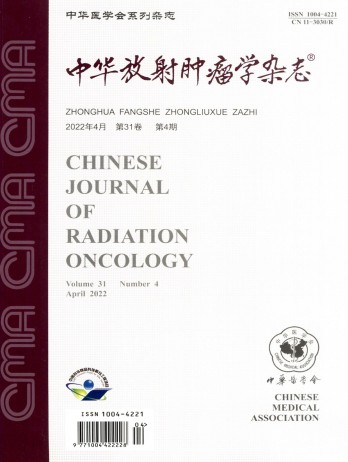Effect of HMGB1 knockdown by RNA interference on cell proliferation and migration of esophageal squamous cell carcinoma after X-ray radiation
引用次数: 0
Abstract
Objective To evaluate the effect of X-ray radiation on cell proliferation, migration, survival ability and cell cycle of human esophageal squamous cell carcinoma after RNA interference-mediated down-regulation of HMGB1 gene expression. Methods The expression of HMGB1 at mRNA and protein levels in the human esophageal squamous cell carcinoma cell lines ECA109 and KYSE30 was determined using RT-PCR and Western blot assays. MTS and Transwell assays were employed to examine the proliferation and migration of ECA109 and KYSE30 cell lines. The cellular survival ability in vitro was assessed by clone formation assay. The cell cycle after X-ray radiation in different groups was detected by flow cytometry. Results The expression of HMGB1 at mRNA and protein levels in ECA109 and KYSE30 cells were markedly higher in a dose-dependent and time-dependent manner in the radiation group than that in the control group (all P<0.05). MTS results demonstrated that the proliferation of ECA109 and KYSE30 cells was obviously lower at each time point after radiation than that in the group without radiation (all P<0.01). The expression of HMGB1 at mRNA and protein levels was significantly inhibited in the HMGB1 siRNA group than those in the control and NC groups (both P<0.01). The data from the clone formation assay revealed that the radiosensitivity was significantly increased after down-regulation of HMGB1 expression (P<0.01). Transwell migration assay revealed that the number of migrating cells at the fourth hour after X-ray irradiation in the HMGB1 siRNA group was significantly lower than those in the control and negative groups (both P<0.01). In the HMGB1 siRNA group, the percentage of cells at G0/G1 phase was obviously higher, whereas the percentage of S phase was significantly lower than those in the control and NC groups, and the trend was even more significant after X-ray radiation (all P<0.01). Conclusion Inhibition of HMGB1 expression by siRNA can suppress the proliferation and migration of ECA109 and KYSE30 cells and enhance the radiosensitivity by increasing the cell cycle arrest at G0/G1 stage after X-ray irradiation in vitro. Key words: HMGB1 gene; Cell proliferation and migration; Cell cycle; RadiosensitivityRNA干扰敲低HMGB1对食管鳞状细胞癌X射线照射后细胞增殖和迁移的影响
目的探讨x射线辐射RNA干扰下调HMGB1基因表达后对人食管鳞状细胞癌细胞增殖、迁移、存活能力及细胞周期的影响。方法采用RT-PCR和Western blot方法检测HMGB1在人食管鳞癌细胞株ECA109和KYSE30中mRNA和蛋白水平的表达。采用MTS和Transwell法检测ECA109和KYSE30细胞系的增殖和迁移。通过克隆形成实验评估体外细胞存活能力。用流式细胞术检测x射线照射后各组细胞周期变化。结果放疗组ECA109和KYSE30细胞HMGB1 mRNA和蛋白表达水平均显著高于对照组,且呈剂量依赖性和时间依赖性(P<0.05)。MTS结果显示,放疗后各时间点ECA109和KYSE30细胞的增殖明显低于未放疗组(均P<0.01)。HMGB1 siRNA组HMGB1 mRNA和蛋白水平的表达均显著低于对照组和NC组(P<0.01)。克隆形成实验数据显示,下调HMGB1表达后,放射线敏感性显著提高(P<0.01)。Transwell迁移实验显示,x射线照射后第4 h HMGB1 siRNA组的迁移细胞数量显著低于对照组和阴性组(P<0.01)。HMGB1 siRNA组细胞处于G0/G1期的比例明显高于对照组和NC组,而处于S期的比例明显低于对照组和NC组,x射线照射后这种趋势更为显著(P<0.01)。结论siRNA抑制HMGB1表达可抑制体外x射线照射后ECA109和KYSE30细胞的增殖和迁移,并通过增加G0/G1期细胞周期阻滞来增强放射敏感性。关键词:HMGB1基因;细胞增殖和迁移;细胞周期;辐射敏感度
本文章由计算机程序翻译,如有差异,请以英文原文为准。
求助全文
约1分钟内获得全文
求助全文
来源期刊
自引率
0.00%
发文量
6375
期刊介绍:
The Chinese Journal of Radiation Oncology is a national academic journal sponsored by the Chinese Medical Association. It was founded in 1992 and the title was written by Chen Minzhang, the former Minister of Health. Its predecessor was the Chinese Journal of Radiation Oncology, which was founded in 1987. The journal is an authoritative journal in the field of radiation oncology in my country. It focuses on clinical tumor radiotherapy, tumor radiation physics, tumor radiation biology, and thermal therapy. Its main readers are middle and senior clinical doctors and scientific researchers. It is now a monthly journal with a large 16-page format and 80 pages of text. For many years, it has adhered to the principle of combining theory with practice and combining improvement with popularization. It now has columns such as monographs, head and neck tumors (monographs), chest tumors (monographs), abdominal tumors (monographs), physics, technology, biology (monographs), reviews, and investigations and research.

 求助内容:
求助内容: 应助结果提醒方式:
应助结果提醒方式:


